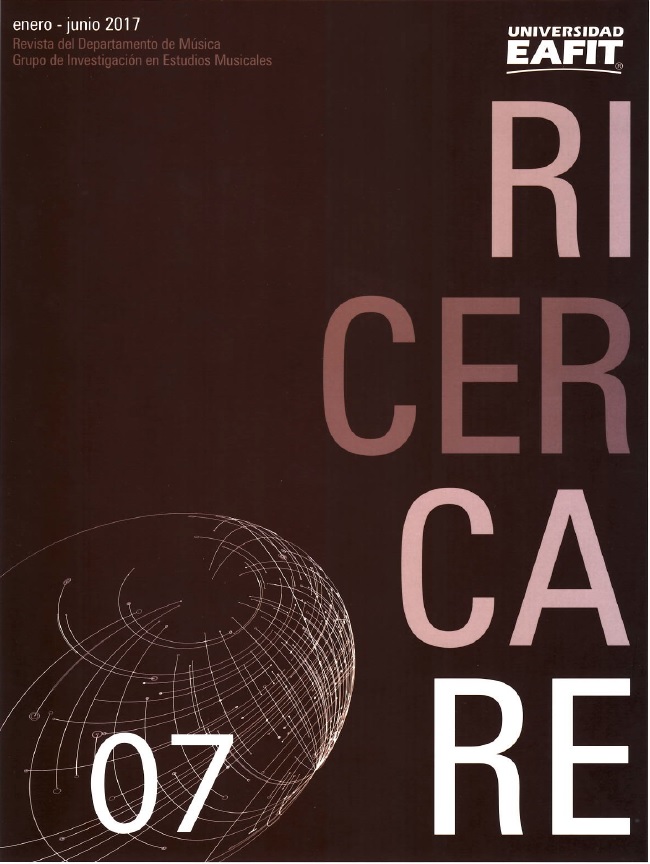Guido of Arezzo: between mistake And serendipity
Main Article Content
Keywords
Guido de Arezzo
Abstract
Few ideas have endured and impacted the history of Western music as Guido de Arezzo’s musical notation, which was formulated almost thousand years ago. This article contextualizes the contribution of the Archaean monk from a political perspective, within the framework of early Christianity and its search for unitary dogmas. From here arises a critical observation of those results, relating Guido’s original intentions with the later development of his ideas. The characteristics of his system gave an impetus to the Pythagorean approach to music, which unwittingly paved the way for many of the principles that operate in our musical life today.
With this in mind, we analyze what Guido did not do and how those shortcomings opened the possibility for the distortion his original ideas.
With this in mind, we analyze what Guido did not do and how those shortcomings opened the possibility for the distortion his original ideas.
Downloads
Download data is not yet available.
References
Amelli. A. (Ed.) (1905). Guidonis Monachi Arentini: micrologusad praestantiores codices mss. exactus.Roma: Desclée Lefebvre. Edit. Pont.
Anglés, H. Gregorian chant (1954). En A. Hughes ( Ed.). Early medieval music up to 1300. New Oxford History of Music, vol. 2. Londres: Oxford University Press.
Antiphonale missarum Sancti Gregorii (1971).Paleographie musicale 10, códice 239 (biblioteca municipal de Laón). Berna: Éditions H. Lang.Aristóxeno (2009). Harmónica-Rítmica. Madrid: Gredos.
Atkinson, C. (2009). The critical nexus: tone-system, mode, and notation in early medieval music. Oxford: Oxford University Press.
Baltzer, R. (Ed.) (1997). Magnus liber organi de Notre Dame de Paris, volume I: parisian organa tripla and quadrupla. París: L'OiseauLyre.
Cantatorium: IXe siècle (1968). Paléographie musicale, deuxième série, monumentale 2, Nº 359(Biblioteca de Saint-Gall). Berna: Éditions H. Lang.
Dahlhaus, C. (1997). Fundamentos de la historia de la música. Barcelona: Gedisa.
D’Arezzo, G. (1955). [Micrologus]; Guidonis Aretini micrologus. J. S. van Waesberghe (Ed.). Middleton: American Institute of Musicology.
De la Cuesta, I. F. (2004). Historia de la música española. 1. Desde los orígenes hasta el «ars nova». Madrid: Alianza Editorial.
Ferguson, N. (1997). Virtual history: alternatives and counterfactuals. Nueva York: Basic Books.
Fubini, E. (2005). La estética musical desde la antigüedad hasta el siglo XX. Madrid: Alianza.
Goodall, H. (2011). Big bangs. Londres: Random House.
Johnson, M. (1990). The body in the mind. Chicago: The University of Chicago Press.
Mews, C. J. (2011). Gregory the Great, the rule of Benedict and Roman liturgy: the evolution of a legend. Journal of Medieval History, 37( 2) , 1 2514 4 .
Pirenne, H. H. P. (1996). Historia de Europa: desde las invasiones hasta el siglo XVI. México: Fondo de Cultura Económica.
Saint Clement (of Alexandria) (1919). Clement of Alexandria: the exhortation to the Greeks: the rich man's salvation: and the fragment of an address entitled to the newly baptised. Cambridge: Loeb Classical Library, Harvard University Press.
Schaff, P., & Wace, H. (1890). A select library of the Nicene and Post-Nicene fathers of the Christian church: second series(vol . 1). Nueva York: Parker.
Strunk, O. (1950). Source readings in music history: from classical antiquity through the Romantic era. Nueva York: W. W. Norton & Company.
Wegman, R. (2003). Historical musicology: is it still possible? En M. Clayton., T. Herbert, & R. Middleton (Eds.). The cultural study of music: a critical introduction. Londres: Routledge.
Zapke, S. (Ed.). (2007). Hispania vetus: manuscritos litúrgico-musicales: de los orígenes visigóticos a la transición francorromana, siglos IX-XII. Bilbao: Fundación BBVA
Anglés, H. Gregorian chant (1954). En A. Hughes ( Ed.). Early medieval music up to 1300. New Oxford History of Music, vol. 2. Londres: Oxford University Press.
Antiphonale missarum Sancti Gregorii (1971).Paleographie musicale 10, códice 239 (biblioteca municipal de Laón). Berna: Éditions H. Lang.Aristóxeno (2009). Harmónica-Rítmica. Madrid: Gredos.
Atkinson, C. (2009). The critical nexus: tone-system, mode, and notation in early medieval music. Oxford: Oxford University Press.
Baltzer, R. (Ed.) (1997). Magnus liber organi de Notre Dame de Paris, volume I: parisian organa tripla and quadrupla. París: L'OiseauLyre.
Cantatorium: IXe siècle (1968). Paléographie musicale, deuxième série, monumentale 2, Nº 359(Biblioteca de Saint-Gall). Berna: Éditions H. Lang.
Dahlhaus, C. (1997). Fundamentos de la historia de la música. Barcelona: Gedisa.
D’Arezzo, G. (1955). [Micrologus]; Guidonis Aretini micrologus. J. S. van Waesberghe (Ed.). Middleton: American Institute of Musicology.
De la Cuesta, I. F. (2004). Historia de la música española. 1. Desde los orígenes hasta el «ars nova». Madrid: Alianza Editorial.
Ferguson, N. (1997). Virtual history: alternatives and counterfactuals. Nueva York: Basic Books.
Fubini, E. (2005). La estética musical desde la antigüedad hasta el siglo XX. Madrid: Alianza.
Goodall, H. (2011). Big bangs. Londres: Random House.
Johnson, M. (1990). The body in the mind. Chicago: The University of Chicago Press.
Mews, C. J. (2011). Gregory the Great, the rule of Benedict and Roman liturgy: the evolution of a legend. Journal of Medieval History, 37( 2) , 1 2514 4 .
Pirenne, H. H. P. (1996). Historia de Europa: desde las invasiones hasta el siglo XVI. México: Fondo de Cultura Económica.
Saint Clement (of Alexandria) (1919). Clement of Alexandria: the exhortation to the Greeks: the rich man's salvation: and the fragment of an address entitled to the newly baptised. Cambridge: Loeb Classical Library, Harvard University Press.
Schaff, P., & Wace, H. (1890). A select library of the Nicene and Post-Nicene fathers of the Christian church: second series(vol . 1). Nueva York: Parker.
Strunk, O. (1950). Source readings in music history: from classical antiquity through the Romantic era. Nueva York: W. W. Norton & Company.
Wegman, R. (2003). Historical musicology: is it still possible? En M. Clayton., T. Herbert, & R. Middleton (Eds.). The cultural study of music: a critical introduction. Londres: Routledge.
Zapke, S. (Ed.). (2007). Hispania vetus: manuscritos litúrgico-musicales: de los orígenes visigóticos a la transición francorromana, siglos IX-XII. Bilbao: Fundación BBVA

